Posted: April 21st, 2015 | Author: Nathan | Filed under: field recording
I’m in the Mojave National Preserve. Massively underrated location, more Joshua trees per acre than Joshua Tree National Park. Gorgeous. Quiet.
My girlfriend is photographing wildflowers in a shallow roadside arroyo. The road follows a set of train tracks; there are small bridges over each arroyo, wash, and ditch. I’m a little bored.
I hear a distant train.
“Where the hell is my field recorder?!?!”
I rummage through the back seat of our car, packed with disorganized camping gear. I violently toss out three huge bags to get at the small Pelican case that holds my Sony PCM-D50. The train gets closer.
I switch on up the D50: No power. “F#&%!!!” I dump the dead batteries into the desert sand, slam fresh batteries in. I toss the Pelican case in the sand and sprint to the small concrete bridge over the arroyo. I slate the take as I run. The train is now visible and almost at the bridge, arriving from my right. I’m rolling. I’m ready…or so I think, having never recorded a train close up before.
The train has two locomotives at the front: They absolutely overload the mics and kick in the D50’s horrendously useless limiters. “S#!%!!!”
But then the cars start rolling by, at least 30dB less loud than the engines. I’m taken aback by the loudness difference and the relative quiet of the cars’ wheels. I’m only 18″ away from the rails; the center of the wheels are at my eye level, elevated above the wash I’m standing in. The old freight cars make a solid chack-chack-chack rhythm, sometimes a galloping sound like a 12-legged horse. The modern liquid container cars produce a smooth, buttery whoosh as they pass. The final engine passes by, screaming like a spacecraft in a sci-fi movie.
I think, for a moment, that I will have no photo to accompany this sound on my blog. Then I do my absolutely ugliest, uncoordinated happy dance, seen only by the ravens and the bees.
[soundcloud url=”https://api.soundcloud.com/tracks/200341399″ params=”color=ff5500&auto_play=false&hide_related=false&show_comments=true&show_user=true&show_reposts=false” width=”100%” height=”166″ iframe=”true” /]
Tags: desert, field recording, industrial, machine, sound effects, vehicle | No Comments »
Posted: June 17th, 2014 | Author: Nathan | Filed under: field recording

It’s been an inordinately windy spring, even for the infamously windy San Francisco area. A previous post captured the sound of my fence swaying in heavy winds, and recently I discovered that my garage door not only creaks and groans in heavy winds, parts of it start vibrating.
So, into the garage with my MKH 50 I went…this high-pitched hiss in the background are leaves on a camphor tree just on the other side of the door. (I freely admit that while I was using a mid-side pair during recording and, ummm, well…I only had one track on my Sound Devices 702 armed to record. Sounded great in mid-side, but ya know what? You get to hear it in glittering, stunning mono!)
[soundcloud url=”https://api.soundcloud.com/tracks/152211065″ params=”color=ff5500&auto_play=false&hide_related=false&show_artwork=false&show_comments=true&show_user=true&show_reposts=false” width=”100%” height=”166″ iframe=”true” /]
| No Comments »
Posted: June 3rd, 2014 | Author: Nathan | Filed under: field recording, found sound objects

Contact mics are bloomin’ fun.
They say that wind in the San Francisco Bay Area doesn’t blow, it sucks. Actually, that’s physically accurate.
When California’s Central Valley heats up, the Sierra Nevada mountain range prevents the air from moving east, so it goes straight up. The cool, heavy air from the western coast then rushes in to fill the gap. This is what causes San Francisco’s famed summer winds and fog, creating summers that feel colder than winters.
Depending on what you’re trying to record, this can be a blessing or a curse. When I saw part of my fence moving about in 15-20 knot winds, I figured something interesting was happening. I could hear some subtle creaking, but if my ears were hearing it, I figured more was going on beneath the surface.
Windy days, of course, are great times to pull out the contact microphones. (Coincidentally, Tim Prebble just announced his second contact microphone sound library at the time of this writing.) No windscreens, no infrasound distortion, nothing. When I placed my contact mic on a fencepost, I got not only wood creaks, but the strain of metal wires tied into the fence to promote upwards growth of roses and vines. This added a metallic overtone that’s quite interesting.
It feels evocative of the strains and groans of a ship heaving at sea, or a castle gate straining under the weight of many warriors or beasts of war (recorded as always at 192khz, this kind of material sounds great pitch shifted -2 octaves). It’s been nice to get back to the world of contact microphones! Posted with no processing whatsoever, so you can actually hear some nearby windchimes in the background if you listen carefully, whose vibrations must have been picked up by the planks in the fence.
[soundcloud url=”https://api.soundcloud.com/tracks/148088989?secret_token=s-kN3PE” params=”color=ff5500&auto_play=false&hide_related=false&show_artwork=false” width=”100%” height=”166″ iframe=”true” /]
| 1 Comment »
Posted: April 25th, 2014 | Author: Nathan | Filed under: field recording, found sound objects
This post doesn’t have a whole lot of details around it, but the sound is neat.
I don’t remember the hotel. Was it the crappy motel in Monterey? The mildewed joint in Fort Bragg? Something more upscale on a work trip? I really don’t recall. But I remember the showerhead.
There was an aerator on the showerhead that, when the water wasn’t quite all the way off, made the most interesting sound as it sputtered out small air pockets in between drops. It sounded purely electrical and nothing like water at all. Check it out.
[soundcloud url=”https://api.soundcloud.com/tracks/140293893″ params=”color=ff5500&auto_play=false&hide_related=false&show_artwork=false” width=”100%” height=”166″ iframe=”true” /]
Tags: field recording, noise, urban | No Comments »
Posted: April 16th, 2014 | Author: Nathan | Filed under: field recording, nature recording
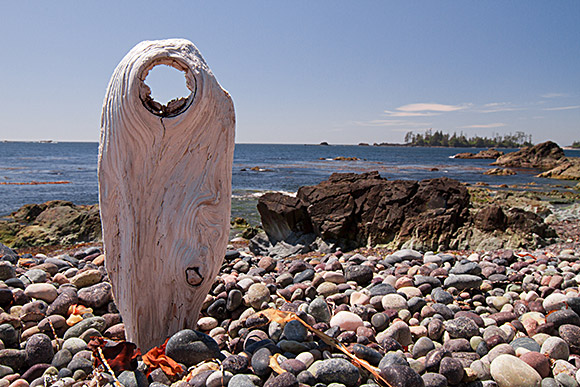
The view west to the Pacific Ocean from Catala Island, British Colombia, Canada.
During my 2013 kayak-camping expedition on the west coast of Vancouver Island, I spent a day by myself photographing and field recording Catala Island. You know you’re in a remote area when you refer to Vancouver Island as “the mainland.”
I found myself on a beach away from the direct Pacific swell, with a nice mix of pebbles and cobbles that made a wonderful rainstick-like tone when the gentle waves receded. (Of course, I’ve posted on recording waves before.)
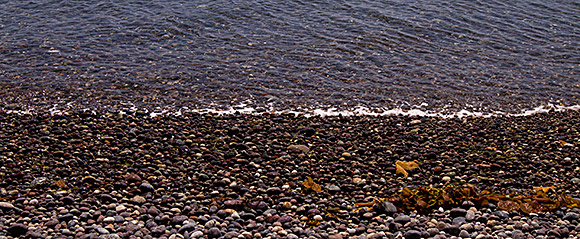
Cobble cobble cobble.
But as isolated as I was, man made sounds still managed to intrude. A lonely acoustic buoy in the distance bleated like a seasick cow on every incoming swell. You may be able to hear this in the background of this recording, faintly, although an aggressive 130Hz high pass filter helped remove the worst of it. Luckily this also removed the distant roar of the sea, actually helping to focus the sound on the small waves that really didn’t have much low-end to them at all.
Many dozens of miles from any road, on an island off another island off the main continent, the sounds of man still pervade. Or perhaps invade.
[soundcloud url=”https://api.soundcloud.com/tracks/140290561″ params=”color=ff5500&auto_play=false&hide_related=false&show_artwork=false” width=”100%” height=”166″ iframe=”true” /]
Tags: ambience, field recording, water | No Comments »
Posted: April 10th, 2014 | Author: Nathan | Filed under: field recording

The MV Uchuck III, passenger vessel and freigher on the west coast of Vancouver island. Kayak for scale.
One of the many reasons this site experienced an almost 1-year hiatus was a self-supported 2-week kayak expedition (check out the video of this amazing trip) on the northwest coast of Vancouver Island. The island is so riddled with deep networks of inlets that it’s actually quite hard to actually get to the exposed west coast. So, at the tiny logging town of Gold River, BC, we put our kayaks on the MV Uchuck III to get motored out to the coast.
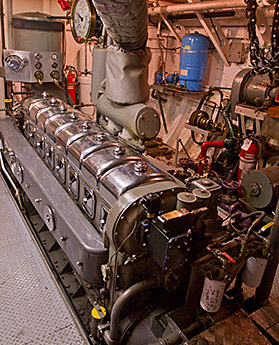
The MV Uchuck III engine room, starboard engine.
The Uchuck III is a lifeline for those that live on the edge of the world, where no roads exist and all travel must be by boat. The Uchuck III brings mail, deliveries, empty dumpsters, groceries, supplies, fish farm provisions, passengers and kayakers from Gold River out to Kyuquot, where we started our trip. It plays a vital role in this extremely remote region, and many generations of skippers and engineers have plied this route. The boat is so storied that there’s even a book about it and its predecessors.
The Uchuck III is a heavily modified World War II minesweeper. The inner double hull and stabilizers were removed to make room for a cargo hold, a crane was added, and the pilot house was moved astern. Its two propellers are powered by one straight-eight diesel engine apiece (a more cranky and surly version of the MV Tutoko, which I rode and recorded in the inlets of New Zealand’s Fiordland), and the skipper can’t control the engines from the pilot house: An actual telegraph is used to relay coded bell rings to the engineer below to take certain actions and “shift gears.” When this thing breaks down, parts need to be machined in Vancouver, from the original construction plans kept aboard.
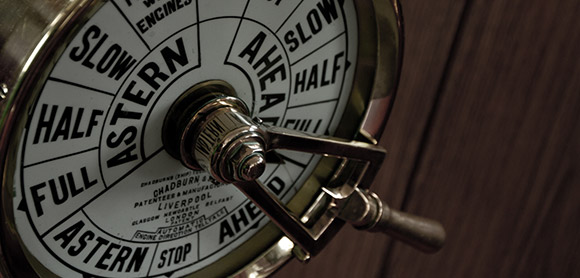
The engine telegraph unit.
Because we were just passing through, essentially, I didn’t get a chance to record too much material, but this post contains some of the perspectives I captured of the ship’s engines and cargo crane. Being a kayak expedition, I only had room for my Sony PCM-D50 recorder, which sucked for nature recording while kayaking…but it was more than sufficient for the loud pounding of the Uchuck III’s twin diesel engines.
[soundcloud url=”https://api.soundcloud.com/tracks/140290347″ params=”color=ff5500&auto_play=false&hide_related=false&show_artwork=false” width=”100%” height=”166″ iframe=”true” /]
Tags: engine, field recording, industrial, machine, mechanical, vehicle, water | 2 Comments »
Posted: April 2nd, 2014 | Author: Nathan | Filed under: field recording, gear, sound design
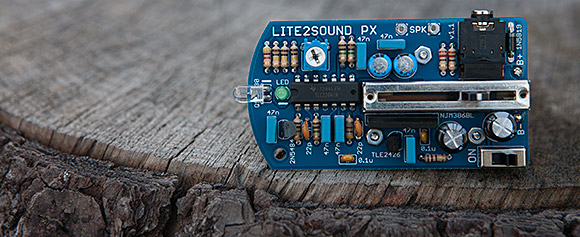
Rare Waves’ Lite2Sound PX, by Eric Archer: A photonic microphone!
I’ve previously written about the heavily-built, wickedly cool Grendel Drone Commander synth from Eric Archer. I check his site, Rare Waves, from time to time for new handmade electronic toys, and I was really intrigued by his newer Lite2Sound PX unit. This small device, in Eric’s words, “extracts audio from ambient light.” It’s a photodiode amplifier. Or a photosensitive microphone. Point it at light, it makes sound. It runs off a 9-volt battery, has a volume control, and a headphone jack. Simple, exciting, and a whole new world of sonic insanity. You can buy them as kits or, as I did, fully assembled.
Sounds pretty straightforward. If you just point it at bright, broad light sources, it’s kind of disappointing. It’s when you start listening to artificial lights in otherwise dim environments that some serious magic starts to happen. My experiments were conducted in and around high tech computer equipment, running an 1/8″ mini jack from the headphone output into my Sony PCM -D50 recorder.
Lights inside of PCs, modulated by fans…and further modulated by speaker grills as I passed the Lite2Sound from side to side. Ethernet network activity lights. Server disk access indicator lights. A close up of the power button of an XBox 360 while booting up. Pulsing lights of devices in standby mode. Halogen lamps behind spinning desk fans.
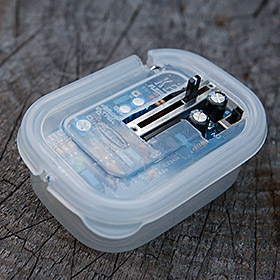
Lightly armored for future fieldwork!
The resulting sounds were astounding in their range: Static, glitches, distorted synth pads, pure sinewave tones, sawtooth-like tones, and much more. You can’t control it, really. It’s a tool of discovery, and its very nature encourages constant experimentation. It was so small and so perfectly complemented a handheld field recorder, I just wanted to take it everywhere and point it at everything! It imparted the same joy as when you start recording with contact microphones, or hydrophones: A new way to listen to the world around you. The more I used the Lite2Sound, I put it in a small plastic container (hacked with an XActo knife for access to controls and the headphone jack) in order to keep the components better protected.
Lite2Sound is a pretty narrowly-focused device and how useful it is to you depends on your taste for the unpredictable. Me, I adore this thing. Hell, I bought two (for future stereo photo-phonic insanity). It encourages constant experimentation, weighs nothing, and I can see using its output in both sound design and musical contexts. Eric Archer nails it again with an odd concept and a rock-solid, focused execution that results in a toy that just begs to be played with.
[soundcloud url=”https://api.soundcloud.com/tracks/139812053″ params=”color=ff5500&auto_play=false&hide_related=false&show_artwork=false” width=”100%” height=”166″ iframe=”true” /]
Tags: audio equipment, digital audio, field recording, sound design, sound effects | 3 Comments »
Posted: December 2nd, 2012 | Author: Nathan | Filed under: field recording, nature recording, sound design
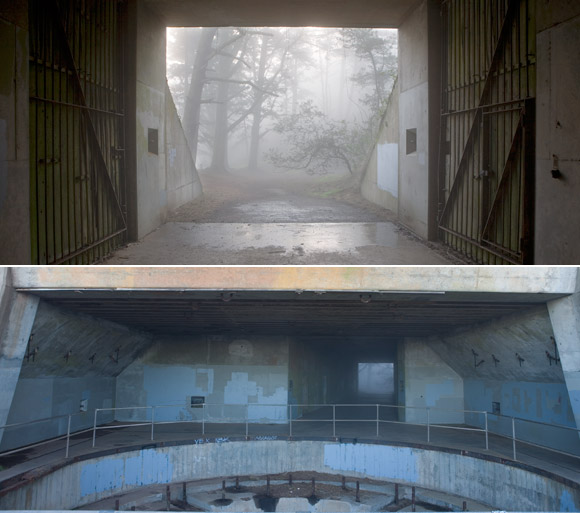
“Construction 129,” a never-completed gun emplacement overlooking the entrance of the Golden Gate, Fort Cronkhite, Marin Headlands, California.
When a winter storm was forecast for the San Francisco Bay Area, I decided to head to the Marin Headlands and try my luck recording bad weather in the abandoned gun emplacements and military fortifications of Fort Cronkhite. I had previously found some great metal sounds at Fort Baker, also in the Headlands, and I was also inspired by Tim Prebble’s high-wind-sub-bass-generator post.
Unfortunately for me, the storm track was slower than predicted, and I wasn’t able to record in peak wind, although some moderate rain started to fall. Such things happen, even with the best of intentions. So, what do you do when your primary plan doesn’t pan out? You reset your expectations and record what you can. I mean, c’mon, I’m in these amazingly evocative ruins! Surely there’s something that’s audibly interesting!
So, I decided to record rain in the tunnels. A recent re-viewing of Ridley Scott’s Prometheus reminded me that tunnels and caverns in films often feature water drops that are drenched in heavy reverb. I pressed the “record” button in several settings and closed my eyes: Was I in the bowels of an ancient spacecraft? The Mines of Moria? The hull of a leaky, empty freighter?
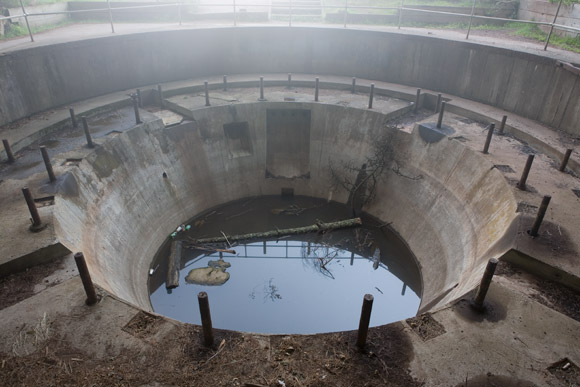
The gun emplacement at Construction 129. No weapon was ever installed.
Occasional wind blasts forced me to enable a high pass filter at 120Hz to try to remove some of the ambient rumble that didn’t help the recording. In addition, there are no fewer than three foghorns in the Marin Headlands, so I had to make an edit every 50 seconds to eliminate the lonely bleat of the Point Bonita lighthouse horn.
There is always something worth recording. You just need to let your disappointment go, reset your expectations with some beginner’s mind, and just start rolling.
[soundcloud url=”http://api.soundcloud.com/tracks/69735256″ params=”auto_play=false&show_artwork=false&color=ee0000″ width=”100%” height=”166″ iframe=”true” /]
[Sennheiser MKH 30/50 mid-side stereo pair into Sound Devices 702 recorder]
Tags: field recording, nature recording, rain, ruins, sound design, sound effects, tunnel, water | 2 Comments »
Posted: December 1st, 2012 | Author: Nathan | Filed under: field recording, gear

The Nexto DI NVS1501 is a burly, professional, and pricey way to back up flash media in the field without a host computer.
[Editorial note: This is an expression of my opinions about this piece of equipment. It was purchased and not provided by the manufacturer. I have no relationship with any company listed below.]
There aren’t many options available for in-the-field, no-computer backups for those of us recording to flash media, like Compact Flash cards, Memory Sticks, and SDHC cards. The most readily-available solutions are usually oriented towards photographers, focusing more on being digital photo albums than professional devices that makes our data more secure, and sometimes only accept JPGs, not arbitrary file types (like, oh, say, .wav files). Some devices, like the Sound Devices 700 series field recorders, will let you write to two pieces of media at once, but what about trips so long that you might need to reclaim CF card space? Or the other devices that we bring with us, like cameras, which can’t do that? Or the majority of trips that I take where carrying a laptop is more hassle or risk than it’s worth?
Enter Nexto DI, a little-known Korean manufacturer of field backup devices oriented towards filmmakers and cinematography digital imaging (DI) technicians. I decided to try the Nexto DI NVS1501 in its 500GB size as a field backup device for four specific pieces of media-capture gear, which could all be in my kit on some trips: the Sound Devices 702 field recorder, the Sony PCM-D50 handheld field recorder, the Canon 7D DSLR, and the GoPro HD Hero 2 POV camera.
Read the rest of this entry »
Tags: audio equipment, backup, field recording, review, travel | 3 Comments »
Posted: November 12th, 2012 | Author: Nathan | Filed under: field recording, sound design

The Uptown, Mission District, San Francisco. Photo source unknown.
The Uptown is the closest bar to my office, and is a classic Mission District hipster dive bar. One hot, Indian Summer day in the fall, it was filled with patrons, windows flung open…but the jukebox was off. And everyone was concentrated by the bar and front door, leaving the back area empty.
Anyone who tries to record diffuse crowd sounds, or “walla,” knows that this is a golden moment. Human voices, but little intelligible conversation, no background music, not too far away from the noise source. I ordered a beer, sat as far away from everyone as I could, and started rolling on my handheld recorder.
I did a little trickery by taking a segment of the recording, swapping the left and right channels, and layering it with another segment, to effectively double the number of people in the room. Luckily there wasn’t too much background noise to also get multiplied. Perhaps not the most interesting of moments on its own, but the little details of the cash register ring, squeaky door hinges, and the general density of the human sounds represents (to me, anyway) a surprisingly hard-to-capture scene without the intrusion of music.
[soundcloud url=”http://api.soundcloud.com/tracks/37831942″ params=”auto_play=false&show_artwork=false&color=ee0000″ width=”100%” height=”166″ iframe=”true” /]
[Sony PCM-D50 recorder, capsules at 120°]
Tags: ambience, sound design, sound effects, urban, voice | No Comments »












